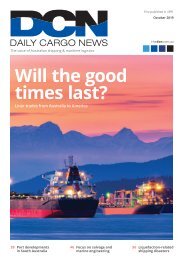DCN0718_Combined_150
Create successful ePaper yourself
Turn your PDF publications into a flip-book with our unique Google optimized e-Paper software.
LOGISTICS & SUPPLY CHAIN<br />
LINX IN THE CHAIN<br />
How a Sydney intermodal park may ease congestion around Port Botany and provide a smoother<br />
supply chain for importers and exporters to Brisbane and the international market<br />
Talk to LINX Cargo Care chief executive Anthony Jones<br />
about Enfield Intermodal Terminal and there’s no mistaking<br />
his enthusiasm.<br />
“The excitement is where it sits in the rail geography. It is<br />
perfectly positioned on the junction of the Southern Freight<br />
Line, the Port Botany dedicated freight line and also the<br />
freight network up into Strathfield and up north,” he tells Daily<br />
Cargo News.<br />
“When I look at it as a rail infrastructure supply chain<br />
solution, we can offer an intermodal terminal without any<br />
inefficiency.<br />
“We see the terminal as being highly efficient and highly<br />
productive with great infrastructure… we know this will work<br />
and we know we will be able to give value back to the importers<br />
and exporters.”<br />
To recap, earlier this year it was announced LINX had<br />
secured the right to lease and operate the Enfield Intermodal<br />
Terminal in western Sydney, a facility previously operated<br />
by Aurizon.<br />
LINX is also to operate a port shuttle service between the<br />
terminal and Port Botany, 18km away.<br />
Some key features:<br />
• 15.1ha of leasehold from NSW Ports<br />
• Annual terminal capacity of 300,000 TEU<br />
• Two rail sidings of 920 metres in length and through-line of<br />
1800 metres, enabling the management of longer trains.<br />
The terminal is part of the Enfield Intermodal Logistics<br />
Centre which includes warehousing, buildings and vacant<br />
land for the development of rail-related warehousing, freight<br />
forwarding, transport and import/export facilities.<br />
Currently the terminal handles about 24,000 TEU equivalent,<br />
so considerable growth is anticipated.<br />
Mr Jones indicates the company is keen to maximise capacity.<br />
“Our aim is to drive that throughput so we maximise that full<br />
300,000-TEU capacity and work in closely with the stevedores,<br />
the truck access providers and the NSW government,” he says.<br />
He notes forecast throughput at Port Botany should<br />
increase demand for the terminal.<br />
To give some context to his statement, a 2015 NSW Ports<br />
study suggested that Port Botany would be handling anywhere<br />
between 7.5m and 8.4m TEU by 2045.<br />
“Facilitating the efficient and sustainable handling of growing<br />
trade volumes through the Port will maximise economic benefit<br />
for the state and minimise environmental impacts on the local<br />
and wider community,” the report authors wrote.<br />
“The key drivers of container growth through Port Botany<br />
are domestic demand, population growth, the strength of<br />
the NSW economy, the value of the Australian dollar, levels of<br />
domestic manufacturing, government trade policies and the<br />
location of key distribution centres.”<br />
Mr Jones says such trends were sure to boost the need for<br />
the Enfield Intermodal Terminal.<br />
“The more growth you have, the more land you need, the<br />
more you can move out to satellite terminals,” he says.<br />
EMPTY CONTAINER PARKS<br />
Mr Jones explains the role of an empty container park capacity<br />
at the terminal (a facility that is still to begin operating).<br />
“We see the empty container park as being critical. It’s<br />
actually not functioning at the moment. We are shuttling boxes<br />
from empty parks to try and triangulate and backload our<br />
export volume,” he says. “Once we get an empty park onsite,<br />
we will be able to bring export trains down from the country<br />
direct into port, backload them with imports and then offload<br />
those imports at Enfield and then reload the empties to go<br />
back up-country.”<br />
THE SIGNIFICANCE OF ENFIELD<br />
DCN asked Mr Jones about the significance of Enfield as part of<br />
its overall business.<br />
“We’re committed to rail... We have our Riverina train; we<br />
have an expanding rail business,” he says.<br />
“So for us, we see this as a bit of a beachhead investment<br />
for us. It gives us a great solution… a solution that will be<br />
attractive, and is already proving to be attractive to importers<br />
and exporters.<br />
“But it also gives us the opportunity (to provide) a Sydney or<br />
a Melbourne solution to our customers.”<br />
LINX<br />
50<br />
First published in 1891<br />
July 2018 thedcn.com.au

















